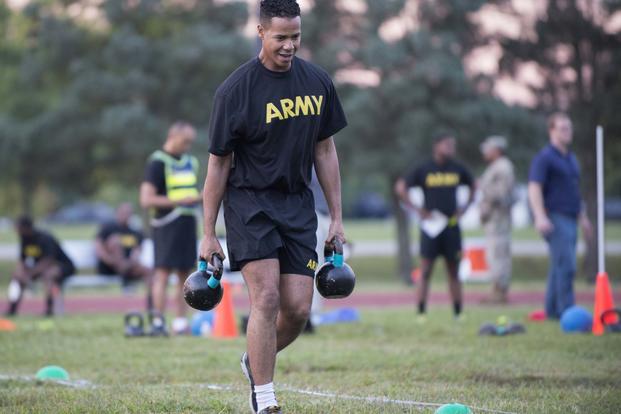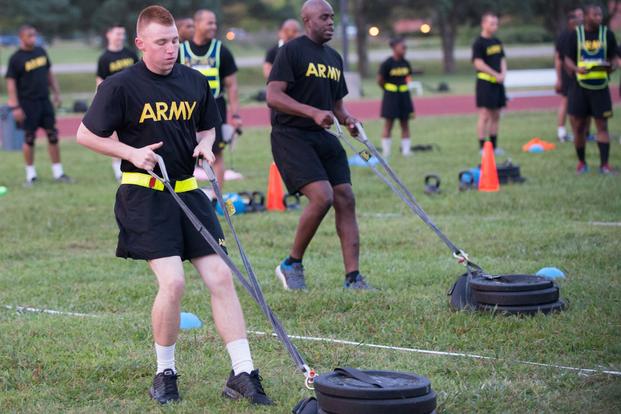The general overseeing fitness for the U.S. Army hopes to see the proposed Army Combat Readiness Test approved next spring and, in time, become the service's standard physical fitness test of record that all soldiers must pass.
The service is in the middle of the Army Combat Readiness Test, or ACRT, pilot, exposing soldiers to the six-event fitness test designed to better prepare them for the rigors of combat than the current three-event Army Physical Fitness Test, or APFT.
The ACRT was developed, at the request of Army Chief of Staff Gen. Mark Milley, to better prepare soldiers for the physical challenges of the service's Warrior Tasks and Battle Drills -- the list of key skills all soldiers are taught to survive in combat.
Related Video:
Army Combat Readiness Test 2017
"As we look at physical fitness, we now know in order to be physically fit in support of the Warrior Tasks and Battle Drills -- what we know we need to do for combat readiness -- we have to be physically fit across five fitness domains," said Maj. Gen. Malcolm Frost, who oversees the ARCT as commanding general of the U.S. Army Center of Initial Military Training.
Related content:
- Army Mulls Redesigning Basic Combat Training, General Says
- Recruiters See Army Physical Assessment Test as a 'Missing Piece'
- Army Considers Adding Drill Sergeants to AIT to Bolster Discipline
Only two of those domains -- cardiovascular endurance and muscular endurance -- are supported by the current APFT, which consist of push-ups, sit-ups and a two-mile run, Frost said.
"There are three domains of physical fitness that are not addressed by that test but are nonetheless necessary ... and those are muscular strength, explosive power, and speed and agility," he said.
'We Aren't Where We Want to Be'
"We have world-class equipment ... but do we have world-class soldiers that are world-class athletes at world-class level fitness? The answer is probably not one that we would want, meaning if you look at a lot of indicators from an individual physical readiness fitness standpoint, we aren't where we want to be," Frost said.
In 2016, the Army had 43,000 soldiers who were non-deployable, he said, adding that in fiscal terms, that equates to a loss of about $3 billion.
"Another staggering figure," Frost said, is that about 78,000 soldiers were above a body-mass index of 30 percent.
"Musculoskeletal injuries about 500,000 a year; 10 million limited-duty days per year -- that's nearly $1 billion," Frost said.
"To put it in fiscal terms is fine, but more importantly it is the lack of readiness due to some sort of physical fitness or readiness aspect -- whether it's injury, whether it's being overweight or whether it is being non-deployable for a medical reason," he said.
The ACRT is made up of six events:
-- Strength Deadlift:
This muscular strength test mimics movements required to safely and effectively lift heavy loads from the ground, then jump, bound and tolerate landing. The exercise is a strong predictor of a soldier's ability to lift and carry a casualty on a litter and to lift and move personnel and equipment.
-- Standing Power Throw:
Soldiers toss a 10-pound ball backward as far as possible to test muscular explosive power that may be needed to lift themselves or a fellow soldier over an obstacle or to move rapidly across uneven terrain.
-- T-Push-Up:
In this event, soldiers start in the prone position and do a traditional push-up but, when at the down position, they move their arms outward and then back in to do another push-up. It is a test of soldier's ability to push an opponent away during man-to-man contact, push a vehicle when it is stuck, and push up from cover or off the ground during evade and maneuver.
-- Sprint/Drag/Carry:
As they dash 25 meters five times up and down a lane, soldiers will perform sprints, drag a sled weighing 90 pounds, and then hand-carry two 40-pound kettle bell weights. This can simulate pulling a battle buddy out of harm's way, moving quickly to take cover, or carrying ammunition to a fighting position or vehicle.
-- Leg Tuck:
Similar to a pull-up, soldiers lift their legs up and down to touch their knees or thighs to their elbows as many times as they can. This exercise strengthens the core muscles since it doubles the amount of force required compared to a traditional sit-up.
-- Two-Mile Run:
This is the same running event as on the current APFT. In the ACRT, run scores are expected to be a bit slower due to all the other strenuous activity.
Part of the ACRT pilot, which is expected to continue into 2018, is working out how leaders will administer the six-event tests.
"Part of the challenge is if we are going to do six events, there is a scope and scale challenge to this -- you can't take a week to test a battalion," Frost said. "You have got to be able to move a company through at the same pace you move a company through to do the APFT."
There is also the challenge of figuring out the correct sequence to the events, he said.
"We have been able to test 50 soldiers in 75 minutes using 10 lanes, so this is doable; it's executable with the right equipment," Frost said.
The plan, he said, is to present the data collected so far in the pilot to Milley "in the next couple of months" and hopefully get a decision to move forward.
If approved, program officials will finalize the test protocol and other details before going back to Milley sometime next spring for final approval to start rolling the ACRT out in 2019 so soldiers can start training for it, Frost said.
"There has got to be a transition period," Frost said. "You have to give them time to ramp up to it."
Soldier Performance Training Centers
As a simultaneous effort, he said, the Army will launch a pilot program next year to develop "soldier performance training centers," which feature the right equipment and resources to help soldiers prepare for the ACRT.
The plan is to put these centers in gyms at three installations and staff them with experts such as trainers, physical therapists and nutrition counselors. Eventually, centers would be established all over the Army, Frost said.
The centers will also need equipment for soldiers to train for the ACRT -- pull-up bars, sleds for dragging weight, deadlift bars, weights and medicine balls.
A battalion set of this equipment to create 10 test lanes retails for about $12,000, but the Army will likely be able to get equipment for less, Frost said.
"If we buy this at scale, it will be much, much, much less, and a lot of this equipment is already out there so we have to kind of inventory what we have and then figure out what the need is," he said.
"And that doesn't mean every battalion is going to get it," Frost said. "You may have a brigade set and every battalion is not going to take the ACRT on the same day, so there are a lot of things we can look at."
Transition Period
But there has to be a transition period before the ACRT can replace the APFT as the test of record, Frost said.
"Whether it is one year or two years, you train on one test -- the other test is a test of record; maybe there is a transition period where both of them can be a test of record," he said. "And eventually, you fade the APFT out -- kind of like you did the gray PT uniform -- and then the ACRT is the enduring test of record."
There also has to be time for the Army to figure out the policy, legal and administrative factors involved with instituting a new test of record since there will be punitive and administrative measures that occur for soldiers who are not able to pass it.
"We are going to need feedback from the field, but my gut tells me before it becomes the test of record, it's probably two years -- so one year to train for it. Another year, maybe it could be a test of record maybe as an option with the APFT," Frost said. "Then at the end of two years, the APFT is faded away, and the ACRT is the only test of record."
-- Matthew Cox can be reached at matthew.cox@military.com.






























